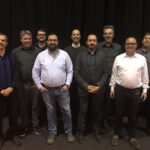|
|
This Presentation date is January 31, 2018 at 13:30 - 14:00.
Presenters: Fred Niehaus
Delegate Panel: Arjan Timmerman, Dominik Pickhardt, Ivan Pepelnjak, Jasper Bongertz, Jens Soeldner, Max Mortillaro, Nicola Arnoldi
Cisco Access Point Designs with Fred Niehaus
Watch on YouTube
Watch on Vimeo
In this Best of Tech Field Day video from Tech Field Day Extra at Cisco Live Europe 2018, Fred Niehaus, from Cisco’s Center of Wireless Innovation, presents on the evolution and design of Cisco Access Points (APs). He delves into the history of Cisco’s AP development, highlighting the shift from early barcode readers and walkie-talkies to sophisticated APs capable of supporting the latest Wi-Fi standards, including 802.11ax (Wi-Fi 6). Fred discusses the challenges of RF design, particularly in creating dual 5 GHz radios within a single AP unit, and how Cisco’s innovations, such as ClientLink and CleanAir technology, set their APs apart. He also explores the future of Wi-Fi technology, touching on the importance of adaptability in AP design to meet evolving standards and user needs. The session includes a detailed look at the technical aspects of AP hardware, such as antenna design and modular capabilities, which allow for custom configurations and enhancements. Fred emphasizes Cisco’s commitment to innovation and the importance of designing APs that not only meet current standards but are also prepared for future advancements in Wi-Fi technology.
Fred began by tracing the history of Cisco’s AP development, starting from early devices like barcode readers and walkie-talkies to the sophisticated APs of today that support the latest Wi-Fi standards, including 802.11ax (Wi-Fi 6). Fred highlighted the significant advancements in AP technology, such as the transition from 15.4-watt power requirements to the need for 30-watt switches to support newer, faster APs. He emphasized the importance of innovations like ClientLink, which provides beamforming capabilities even for older clients, and CleanAir technology, which offers full-spectrum analysis to mitigate interference. These innovations, along with modular designs and smart antenna connectors, allow Cisco APs to adapt to evolving standards and user needs, ensuring they remain at the forefront of wireless technology.
Fred also delved into the technical aspects of AP hardware, discussing the challenges of RF design, particularly the integration of dual 5 GHz radios within a single AP unit. He explained how Cisco’s flexible radio assignment and XOR radios enable APs to operate in various configurations, such as dual 5 GHz mode or as a wireless security monitor. This adaptability is crucial for addressing issues like excessive 2.4 GHz coverage and optimizing network performance. Fred showcased the modular capabilities of Cisco APs, which allow for custom configurations and enhancements, such as adding external antennas or integrating developer modules for specialized applications. He concluded by emphasizing Cisco’s commitment to innovation and the importance of designing robust, reliable APs that not only meet current standards but are also prepared for future advancements in Wi-Fi technology.
Personnel: Fred Niehaus









